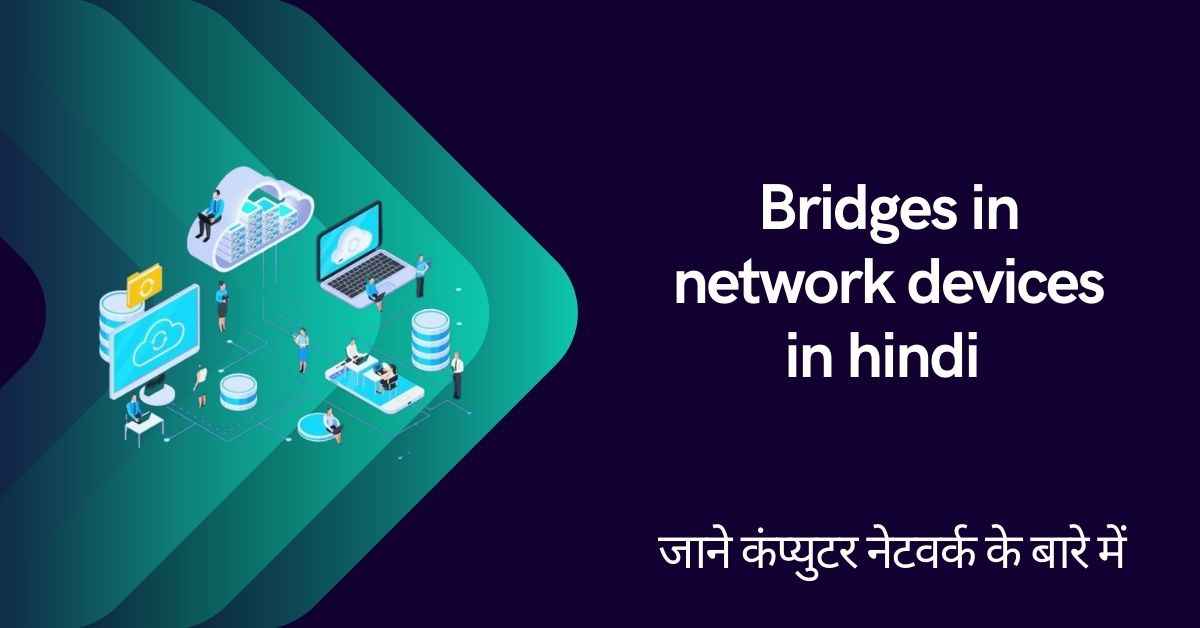Bridges network devices hote hain jo data packets ko ek network segment se dusre network segment mein forward karne ke liye istemal hote hain. Ye devices data link layer (Layer 2) par kaam karte hain aur connected networks ko bridge karke unke beech communication ko facilitate karte hain.
Bridges ka mukhya kaam hai data packets ko unke destination tak pahunchana. Jab data packet bridge par pahunchta hai, toh bridge uske destination MAC address ko dekhta hai aur uske based par decision leta hai ki kis network segment mein ye packet forward karna hai.
Bridges multiple network segments ko connect kar sakte hain aur unko ek logical network banane mein madad karte hain. Ye network segmentation ka kaam bhi karte hain. Agar ek network segment mein bahut saari devices hain aur network traffic ki overload ki problem hai, toh bridge use segment ko alag segments mein divide kar sakta hai. Isse network performance improve hoti hai kyunki traffic limit hoti hai aur packets ko selectively forward kiya ja sakta hai.
Computer Network के ये Topics के बारे में जानें :-
- Persistent and Non Persistent CSMA in computer network in hindi
- CSMA CD in computer network in hindi
Bridges unicast, multicast, aur broadcast traffic ko handle kar sakte hain. Unicast traffic ko sirf destination device tak forward karte hain, multicast traffic ko multiple devices tak forward karte hain (jinhone multicast group join kiya ho), aur broadcast traffic ko sabhi devices tak forward karte hain.
Bridges broadcast domains ko separate karte hain. Ye har network segment ko alag broadcast domain banate hain, jisse broadcast traffic limit hoti hai aur network congestion kam hoti hai.
Bridges MAC address learning ka bhi kaam karte hain. Jab bridge par data packets aate hain, toh wo MAC address ko learn karta hai aur use bridge ke MAC address table mein store karta hai. Isse bridge ko pata chalta hai ki kis network segment mein konsa device hai aur packets ko sahi destination tak forward karne mein help milti hai.
Bridges ek layer 2 device hone ke karan, ye network communication ko enhance karte hain aur network performance ko improve karte hain. Ye data packets ko selectively forward karke network traffic ko optimize karte hain. Bridges network topology mein flexibility provide karte hain aur connected devices ke beech communication ko enable karte hain.
Overall, bridges network segments ko connect karne aur data packets ko forward karne mein madad karte hain. Ye network performance ko improve karte hain aur network traffic ko manage karne mein help karte hain.
Advantage of Bridges in network devices in hindi
Bridges ke istemal se kuch faide hote hain:
- Network Segmentation: Bridges allow network segmentation by dividing a large network into smaller segments. This helps in reducing network congestion and improving overall network performance. Each segment has its own collision domain, which means that the traffic within each segment is isolated, resulting in more efficient communication.
- Reduced Network Collisions: Bridges help in reducing network collisions by selectively forwarding data packets to the intended destination. They examine the destination MAC address of each packet and forward it only to the appropriate segment, preventing unnecessary traffic and collisions.
- Improved Network Performance: By dividing a network into smaller segments, bridges help in reducing network congestion and improving performance. They limit the spread of broadcast traffic and isolate network problems within a specific segment, minimizing the impact on the entire network.
- Enhanced Security: Bridges provide some level of network security by isolating network segments. They restrict the flow of data packets between segments, preventing unauthorized access and limiting the potential impact of security breaches.
- Scalability: Bridges offer scalability by allowing networks to expand and accommodate additional devices. As the network grows, bridges can be added to connect new segments, maintaining efficient communication between the segments.
- Seamless Network Integration: Bridges provide seamless integration between different types of networks, such as Ethernet and Wi-Fi networks. They can bridge the gap between wired and wireless networks, enabling devices from different network types to communicate with each other.
- Fault Isolation: Bridges help in isolating network faults or failures within a specific segment. If a problem occurs in one segment, it does not affect the operation of other segments, ensuring the reliability and availability of the network.
- Lower Cost: Bridges are often more cost-effective compared to other network devices such as routers. They can be used to connect smaller networks or segments within a larger network without the need for complex routing protocols.
Overall, bridges provide a cost-effective solution for connecting network segments, improving network performance, enhancing security, and enabling network scalability. They play a vital role in creating efficient and reliable networks by reducing collisions, managing network traffic, and isolating network issues.


1 thought on “Bridges in network devices in hindi – Computer network”